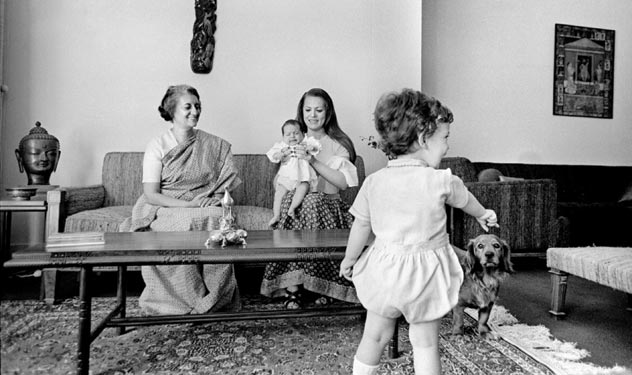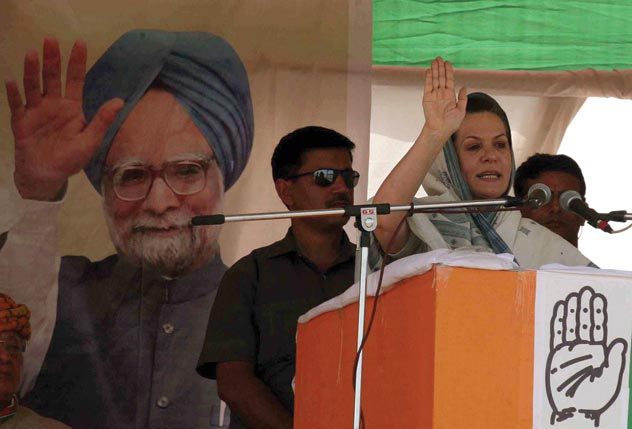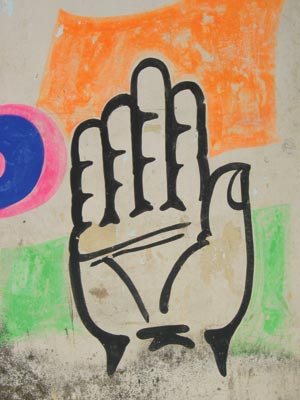SUBCONTINENT
Status Quo, Jai Ho!
Indian Media and Elections
The rampant bias in favor of the ruling Congress Party hasn’t changed at all in many decades, writes a frustrated Partha Banerjee.

(Above): Archival photo of Indira Gandhi, prime minister of India for many years, with daughter-in-law Sonia Gandhi and grandchildren Rahul (in Sonia’s lap) and Priyanka. Sonia’s husband, Rajiv, was also prime minister, Sonia is today leader of the Congress Party, and Rahul is being groomed to be a future prime minister.
Over the past few weeks, I’ve been watching the Indian parliamentary election coverage on the big media, both here in the U.S. and back home. Of course, being in New York, my source of Indian papers and television is primarily through online search, and secondarily through frequent email and phone conversations with family and friends in Kolkata, Delhi and Mumbai. I presume though, in this day and age, that’s more than sufficient; you don’t have to be physically there.
I must say I’m frustrated to see the rampant bias in favor of the ruling party. It’s more frustrating that over the years — since my own political days in India — it hasn’t changed at all. Back then, in the ’70’s and ’80s, it was a Russian Prime Minister Vladimir Putin-like favoritism for Indira Gandhi and then Rajiv Gandhi, both of whom were made “people’s leaders” practically overnight by upper-class establishments. In the 90s and now in the first decade of 2000, the same happy fate has befallen Sonia Gandhi, Manmohan Singh, and following tradition, Rahul Gandhi. The media-supported rise of Rahul Gandhi as the next potential prime minister of India is eerily similar to the rise of Rajiv and his brother Sanjay, for those who remember the tumultuous days.
Government-owned Doordarshan TV and All India Radio — both of which fell from grace in this privatized, U.S.-modeled era — have always shown bias for the party in power; in fact, Congress Party, Jawaharlal Nehru and Indira Gandhi helped create the pro-government spin the Ronald Reagan way. At least in the Nehru regime, it was by default than by active engineering. During the post-1947 days, especially after the Mahatma Gandhi assassination, Nehru became larger than life; just like Congress with its pair of bullocks became a household symbol. Nehru’s out-of-touch, elitist rule characterized with toppling democratically elected governments in various parts of India never got the rightful media exposure or censure. To the Indian media, he was the Bharat Ratna.
If Nehru did it by default, Indira Gandhi did it by her violent exercise of power never to be questioned by media. When her Garibi Hatao (get rid of poverty) slogan miserably failed in the first half of the 1970s and people on the street began mocking it as Garib Hatao (get rid of the poor), and when even sane Congress activists started revolting against Indira’s extreme nepotism to bring her younger, wayward son Sanjay into the national limelight, and especially when the poor started organizing against the out-of-control poverty, inflation and state repression, a royal lifestyle and cult worshipping (the most famous was then Congress president Devkant Barua’s “Indira is India” catch phrase), the first and only woman India prime minister exercised illegal power, clamped down on the opposition with a 1975 emergency rule to void the Allahabad High Court ruling against her election victory, amended the constitution, imprisoned thousands of opposition party activists including most of the leaders, and put blanket censorship on the press.

(Above): Congress Party chief Sonia Gandhi displaying the party’s hand symbol to party supporters during a campaign rally in Halol, Gujarat.
Even for someone like me who was deeply involved with political activism, it came as a shock that Indira put veteran leaders like Jayaprakash Narayan, Atal Behari Vajpayee, L. K. Advani, Raj Narain (Indira’s personal nemesis in Rai Bareilly), George Fernandes, in a word, the top brass of Indian politics in jail, indefinitely, on charges of “anti-India activities.” She passed some emergency legislation in an opposition-free parliament — laws that we can easily compare with today’s TADA or POTA of India or the Patriot Act of the George W. Bush government.
Notable was the fact that the Indian big media never really opposed such autocratic measures. A handful of journalists such as Barun Sengupta, Gaur Kishore Ghosh and Jyotirmoy Datta of Kolkata protested; they were promptly arrested and put behind bars. Patna’s Daily Searchlight was torched.
It is important to remember the stained history of India’s ruling class, particularly the Congress Party, because the younger generation does not know it, again, thanks to selective coverage and distortions of history. A quick history lesson puts the developments today in perspective. It helps us to understand and analyze.
Today, India has witnessed an explosive growth of privatized media corporations: their national and local channels as well as print and online publications have mushroomed across the country. Globalization has helped create alliances between Indian, European and American media giants; just like the recent marriages of soft drinks, energy or insurance companies between India and the U.S., hyphenated media organizations, more powerful than ever before, now pervade India’s upper- and middle-class drawing rooms. Globalized and Americanized private media wield an unprecedented influence on Indian people and electorate, especially the younger generation. Just like the U.S., the media have taken advantage of the age-old perception: “If it’s in the news, it must be true!”
In this backdrop, the role of the government as well as private media such as ZeeTV, NDTV, Star-Anand, CNN-IBN, Times of India, along with their many local and regional offshoots, especially their predisposition to show extreme bias for parties and candidates of their choice, is particularly ominous for democracy. Contrary to the much-touted American media doctrine of a fair and objective reporting — a doctrine they always preach but seldom practice — the new Indian media have resorted to an unrestricted, one-sided coverage of the Congress Party and its leaders. Any half-hour news segment, interspersed between relentless cricket matches or Bollywood stars’ imbecile shows, find headlines and wrap-ups featuring a feeble and visibly energy-less Manmohan Singh, a lackluster, unemotional Hindi speech of Sonia Gandhi, or meaningless, elitist rhetoric of Rahul or Priyanka Gandhi (again, eerily reminding us about their father), and that too, usually about the so-called rise of India as the “next superpower” in the world stage.
 (Right): The ubiquitous symbol of the Congress Party. Despite money and muscle, a poll suggests neither the Congress nor the opposition Bharatiya Janata Party is expected to win more than a quarter of parliamentary seats. (Right): The ubiquitous symbol of the Congress Party. Despite money and muscle, a poll suggests neither the Congress nor the opposition Bharatiya Janata Party is expected to win more than a quarter of parliamentary seats.
Sadly, even now during the election times, voters can find nearly no reporting of the fact that a vast majority of Indians still have no access to health care, education, drinking water or electricity. One wouldn’t know that in India, a world-record number of farmers committed suicide because of economic desperation and multinational companies’ forced seed-bank replacements. By reading or listening to media’s interpretations, one would think India is now as equally and equitably prosperous as Japan, Korea or China. After all, the Nano has come out!
We don’t hear about the destruction of the Indian environment and massive pollution and energy crisis. We don’t hear about the extreme lack of women’s rights (Sure, we now have more fashion shows and jewelry models on the catwalk!). We don’t hear that India is now the fastest-growing AIDS country (and contrary to Thailand or U.S., talking about AIDS is still very much a taboo). We don’t know that police brutality and abuses on social and religious minorities are abysmal. We’re never told that international organizations have called India one of the worst countries in terms of protecting human rights and promoting equality. We’re not reminded that India has seen a massive number of communal riots, big and small, in recent years: not just in Gujarat, Ayodhya or Mumbai. And that our governments have failed miserably to protect us from terrorism.
Nazi leader Joseph Goebbels, the guru of misinformation, said a long time ago, “If you tell a lie big enough and keep repeating it, people will eventually come to believe it.” Goebbels also said, “It thus becomes vitally important for the state to use all of its powers to repress dissent, for the truth is the mortal enemy of the lie, and thus by extension, the truth is the greatest enemy of the state.”
It’s not that Indian opposition parties are telling the truth about the state of affairs either; if anything, the big opposition parties’ hands are also quite dirty. But then, in a much-glorified model of Western democracy India has followed so keenly, what’s the layperson’s alternative? They must know the truth, and media is perhaps the only place where an average, apolitical voter can get it.
The only ray of hope is that poor Indians, if they decide to vote, will vote based on their real-life experience, and not so much because of the incessant pressures from the media, political mafia, village panchayats, town strongmen or family bosses.
But that’s a vain hope indeed — a utopian dream. In reality, it doesn’t much happen. And that is why the Indian media’s suppression of truth and complicity in spreading the ruling class’s rampant lies are even more worrisome. In their election coverage today, opposition parties find minimal amount of time and importance. Third parties and especially those who have mass support to boycott elections are not given any time at all.
The big media have belittled opposition alliances, and brought them to ridicule. Let me cite a rather “civilized” example. On April 16, Times of India reported:
Not ruling out taking its support again to form the government at the centre after the Lok Sabha elections, External Affairs Minister Pranab Mukherjee has said that the ‘Fourth Front’ comprising SP, LJP and RJD would split secular votes.
“They will clearly waste votes. That is their main objective,” the Congress leader said in an interview.
When asked to comment on reports that in the post-poll situation, the Congress might take their support, he said, “I do not know. It will depend on numbers. After all democracy is a game of numbers. What I can say is, we will get adequate number of seats. I can’t predict. We are fighting to win the elections.”
So, according to mighty Mukherjee-saab, democracy is only a game of numbers; it’s not about real people and their real lives or real problems. It’s not about the future of India and her children. Shouldn’t the all-important Times of India have challenged it? Also, wasn’t it time to find the reasons why there’s a fourth front mostly of disillusioned ex-Congressis? Why is it that pre-poll surveys suggest that neither the Congress nor BJP is going to get more than a fourth of the total number of parliamentary seats, in spite of their big money and muscle power?
I want to cite a different example.
Recently, I had the opportunity to watch an NDTV “Town Hall” where well-known journalist Barkha Dutt brought in personalities from various parties to talk about terrorism, economics, etc — things that matter to the electorate. Even though she did a commendable job to put on her show a diverse array of politicians, in reality, it was skewed coverage in favor of the so-called secular state a la Congress Party where religion and spirituality does not seem to count, and also in favor of the “modern India way” where Pakistan in particular is the accepted enemy, where no questions can be asked about the political machinations of India governments around Pakistan (and which power kept supporting Pakistan’s military governments with money and arms). The TV Town Hall of invited guests also heavily favored the now-doomed market-driven U.S. capitalist system where the reasons for the doom were never explained, as if there was no need to question the corrupt, inefficient and poverty-causing system, a system that has now made the U.S. one of the most broken economies.
The biggest irony to me is that a pro-Hindu upper caste, feudal, oppressive system is vindicated in India, and that too, in the name of a Western, liberal democracy. With this, who needs the Hindu right-wing BJP? Worse, what’s the real difference between them?
India is a country where status quo is the name of the game. Nothing really changes. Elections only validate the status quo. We do the democracy exercise every five years spending stupendous amount of money we can’t even afford. Then we go to sleep; rather, we’re put to sleep. The rich and the powerful live happily ever after.
Incredible India! Jai Ho!.
|